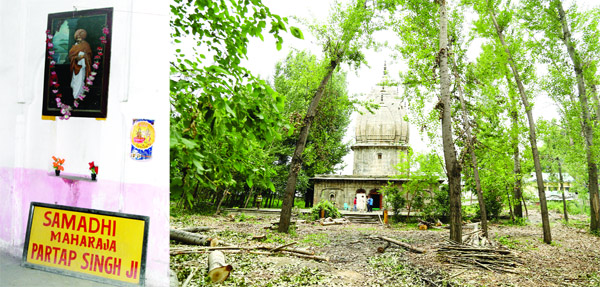Nagendra Singh Jamwal
The rise of Maharaja Gulab Singh from a collectivity of feudal lords to the founder of the modern state of Jammu and Kashmir is a political odessey of the legendary proportions. His Raj-Tilak i.e anointment as Raja of Jammu Territories had a unique symbolism. He was coroneted at Jio Pota Ghat situated on the right bank of Chenab river also known as Askani, one of the holy rivers of Vedic times. The Jio Pota Ghat is adjoining to the Akhnoor fort which to this day remains the northern most point of the Harappan civilization.
However very few people know that Maharaja Gulab Singh died in Srinagar and was cremated at Rambagh. The founder of the modern state of Jammu and Kashmir left for heavenly abode on 30th of June 1857. According to Gulabnama written by Diwan Kripa Ram, Maharaja Gulab Singh died on 20th of the month of Sawan in the year 1914 Bikrami. While coming from Srinagar airport a signboard prominently mentions the Samadhis of the Maharajas of Jammu and Kashmir at Rambagh. For a student of history, the place offers a significant peep into the history and provides valuable information on the founder of the State.
The place where Maharaja was cremated is marked by a platform over which a temple like Samadhi has been constructed. The Samadhi raised on a square platform gives an excellent skyline to the structure making it feel magnificent. While the temple displays the same school of temple building which was prevalent during the Dogra rule, it displays an indelible mark of the Kashmiri artists who are to this day are known as excellent exponents of stone carving and masonry. Instead of using small fire burnt tiles, stones blocks have been used giving solidity and strength to the structure thus making it look imposing.
The Samadhi itself is situated in a vast courtyard enclosed by two storied structure on all sides. According to the local residents it housed the royal stables. While horses were kept in the stables on the ground floor, their attendant staff was housed in the second storey. The Samadhi is constructed in a garden having large Chinar trees planted in rows. The Samadhi has ornate designs on its entrance and displays four female figurines holding musical instruments. The Samadhi rises from a square building having Parikarima. Each side of Parikarima has three arched gateways which now have been blocked by raising brick walls. The only entrance left has been barred by a iron gate. After entering the Samadhi one is pained by the pitiable conditions. The floor is cracked and shows sheer neglect of Samadhi. A signboard declares ‘Samadhi-Maharaja Gulab Singh’ and is placed on the floor instead of being mounted on the wall. A soiled jute mat is spread on the broken floor taking a heavy toll on the ambience of the pious and historical building. Inside the sanctum-sanctorum is a garlanded photograph of the Maharaja. The sanctum-sanctorum also contains a Shiva linga.
The iron-railing of the Samadhi is also damaged. The people living in the place are using it to sun-dry their laundry. Wild growth has invaded the nook and crannies of the structure thus displaying the apathy of the guardians of the property. The whole structure shows signs of decay and neglect. The untended garden too has been occupied by squatters who have encroached on large parts of the property using corrugated iron-sheets.
On the North-East of the garden is a stone platform made out of finely chiseled stone tiles which has now fallen prey to squatters who have placed pots to grow vegetables.
According to the care-taker of the estate, the garden also contains the Samadhi of Maharaja Partap Singh. His Samadhi is grander and more ornately carved as compared to Samadhi of Maharaja Gulab Singh. The sanctum-sanctorum of this Samadhi contains a seven feet high Shiva linga and requires a flight of wooden stairs to pour water (Jala-Abhisheka) on the Shiva linga. Surprisingly the Samadhi also contains a life-size painting of Maharaja Pratap Singh attired in Dhoti – a dress mainly worn by Dogras on holy and auspicious occasion while performing rituals.The painting is worth preserving and affords authentic glimpses into the history.
The garden also has Samadhis of other members of the royal family. While the land and the Samadhis are managed by the Dharmarth Trust, the historical and cultural significance of this place is a shared heritage of the whole state and deserves to be better managed and looked after for the Posterity.
Maharaja Gulab Singh’s contribution to the formation of the modern state of Jammu and Kashmir has been recognized by the historians and general public alike. Let us honour him by improving of the Ram Bagh Samadhi Complex as a befitting tribute to his contributions.
Trending Now
E-Paper


